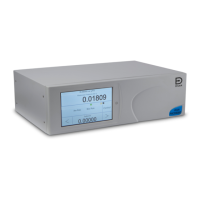Copyright 2008 Baker Hughes Company.
English–PACE5000/6000 Instruction Manual | 45
Operational Requirements
6.2.2 Oil Contamination
Precautions must be taken against oil transfer to the instrument.
A normally-open venting solenoid connected to atmosphere and the pump. When the pump
supply is switched off, the valve opens allowing atmospheric pressure to enter the pump directly
rather than through the pipe (tube) to the instrument.
Note: If the above is not done, oil may progressively move up the supply pipe (tube) and into the
instrument.
6.2.3 Pump Performance
Recommended for ranges above 2
bar (30
psi) gauge, positive full-scale:
1. When installing a vacuum supply, protect the vacuum pump against the discharge of
positive pressure by the controller into the vacuum pump. This may result in reducing
vacuum pump performance.
2. Use a check valve in the negative supply to vent excess pressure to atmosphere if the
vacuum pressure rises above atmospheric pressure. The check valve should be installed on
the instrument side of a volume which is approximately equal to the system volume. The
volume slows any rapid pressure rise giving the vacuum pump time to reduce the pressure.
Note: A wide bore vacuum pipe (tube) can have enough volume. When used with a check valve,
this could provide the necessary overpressure protection.
6.2.4 Venting
Either a zero or vent operation uses the vent port.
6.2.5 Vent
The system gas at the output pressure can be released from the vent port. Unrestricted gas flow
occurs in this operation. Use a controlled method to reduce the system pressure, at a controlled
rate, to near atmospheric pressure then select vent.
6.2.6 Zero
During a zero operation only the internal volume of the instrument vents to atmosphere. Do not
obstruct the vent port. To diffuse gas exhaust, a diffuser may be fitted to the vent port.
6.2.7 Output Port
The output port provides the controlled test pressure to the UUT.
6.2.8 Reference Port
The reference port provides the negative pressure to the gauge sensor and to the barometric
reference (option). Gauge sensors use this port identified as “REF”. For gauge sensors (without
a barometric reference) small pressures can be applied. Refer to Data Sheet. All other pressure
measurements require the port to be opened to atmosphere. When in gauge mode, the
instrument shows the pressure difference between the reference port and the output port.
Note: This is not a true differential operation as there is no true differential calibration of the
sensor.
The transducer of the barometric reference option senses atmospheric pressure via the
reference port. When enabled, the port must be open to atmosphere.
The reference connection should be actively used (differential connection option) for precision
low pressure measurement. The instrument measures pressure relative to the pressure at the
reference port.
An atmospheric pressure change causes the indicator to adjust the displayed pressure. This
appears as instability. To keep a stable displayed pressure, the reference port should be

